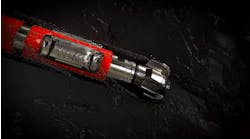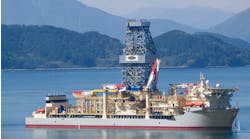Bruce Beaubouef • Houston
Shell continues deepwater discovery momentum
Shell has made a large oil discovery with its Dover exploration well in the Norphlet geologic play in the deepwater US Gulf of Mexico.
The Dover discovery, drilled by the TransoceanDeepwater Poseidon ultra-deepwater drillship, is Shell’s sixth in the Norphlet and encountered more than 800 net ft (244 m) of pay.
The well was drilled in Mississippi Canyon block 612, located about 170 mi (273 km) southeast of New Orleans, in a water depth of 7,500 ft (2,280 m) to a total vertical drilling depth of 29,000 ft (8,839 m) measured depth.
Above: The Dover discovery, located in Mississippi Canyon block 612, is Shell’s sixth in the Norphlet.
Below: The Dover discovery was drilled by the Transocean Deepwater Poseidon ultra-deepwater drillship. (Images courtesy Shell)
Andy Brown, Upstream Director for Royal Dutch Shell, said: “Dover showcases our expertise in discovering new, commercial resources in a heartland helping deliver our deepwater growth priority. By focusing on near-field exploration opportunities in the Norphlet, we are adding to our resource base in a prolific basin that will be anchored by the Appomattox development.”
The discovery is located about 13 mi (21 km) from the Appomattox host and is considered an attractive potential tieback.
Shell’s Appomattox host has now arrived on location in the US Gulf of Mexico and is expected to start production before the end of 2019.
The Appomattox platform is owned by Shell (79%) and Nexen Petroleum Offshore USA Inc. (21%).
Partners submit Zama drilling plans
The Talos Energy-led partnership has submitted an appraisal program for the shallow-water Zama discovery in block 7 offshore Mexico to Mexican government authorities.
According to partner Premier Oil, they plan to drill back-to-back wells and one side track to confirm the oil-water contact, as defined by the seismic flat spot, and to prove the detailed distribution of the reservoir. The well should spud in 4Q.
PEMEX is also negotiating for a rig for the Asab-1 well which will test the extent of the Zama discovery into an adjacent block.
In March, Premier secured interests in three new blocks under Mexico’s Round 3.1 – block 30 in the Sureste basin and blocks 11 and 13 in the Burgos basin.
Plans for block 30 include 3D seismic acquisition and reprocessing of existing 3D seismic across the Wahoo prospect, which exhibits direct hydrocarbon indicators, and which is thought to be analogous to Zama.
In the Burgos basin, the company will commission an environmental base line study across its two blocks prior to reprocessing existing seismic data during 2019.
Top offshore regulator sees ‘renewal of optimism’
The top US offshore safety official says that drilling activity is increasing in the Gulf of Mexico, in part the result of a “renewal of optimism” following President Trump’s push to roll back regulation.
“This administration is very clear on offshore [oil and gas] being a prominent part of America’s energy portfolio, and that impacts companies’ desire to invest,” said Scott Angelle, director of the Bureau of Safety and Environmental Enforcement, in an interview with the Houston Chronicle. “At the same time, energy prices have [also] helped their spirits.”
Angelle cited a BSEE report showing 46 drilling rigs operating in the Gulf of Mexico as of May 14, a level last seen in May 2016. And over the first four months of this year, 35 deepwater drilling permits were issued, almost double the tally from a year ago.
The Chronicle report noted that those numbers differed dramatically from the data published by Baker Hughes, the downhole services firm whose weekly rig count is watched closely by analysts tracking the health of the oil industry. According to Baker Hughes, the rig count in the Gulf of Mexico is 18, down 22% from a year ago.
A spokesman for BSEE explained the discrepancy as stemming from the agency’s data including rigs performing maintenance and other activities, and not just the drilling rigs Baker Hughes counts.
Imran Khan, a senior manager at the research firm Wood Mackenzie, said drilling activity in the Gulf had been fairly flat since 2016, according to the Chronicle report. But he added interest in the region is starting to pick up with the Shell and Chevon deepwater discoveries that were announced in January.
That growing interest is in large part driven to a rise in oil prices, with West Texas Intermediate trading at approximately $70/bbl, its highest level since 2014.
At the same time Trump has been drawing applause from oil executives for his changes to environmental and safety regulations put in place following the Macondo oil spill of 2010.
The moves have drawn criticism from environmentalists and a number of Democrats, who worry the revisions could increase the chance of another large spill.
But in the Chronicle interview, Angelle insisted that his agency only changed 18% of the regulations, known as the well control rule, and stayed within the recommendations made by the bipartisan commission that former President Barack Obama ordered to study the causes of the accident. “We cannot ever sacrifice safety, but at the same time we can be a country that embraces safe operation and robust production,” Angelle was quoted to have said.






